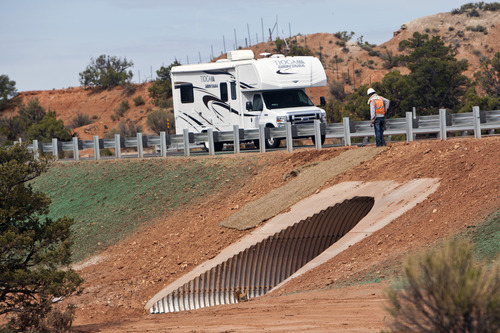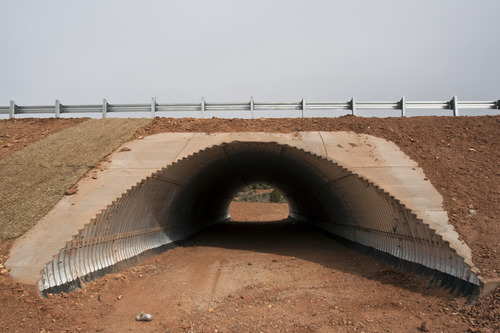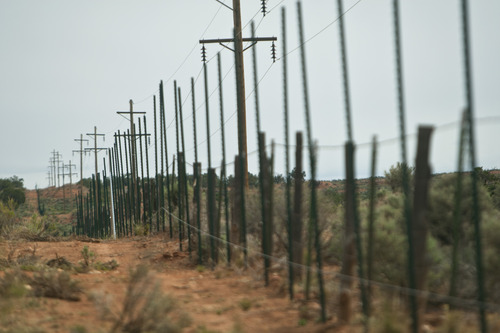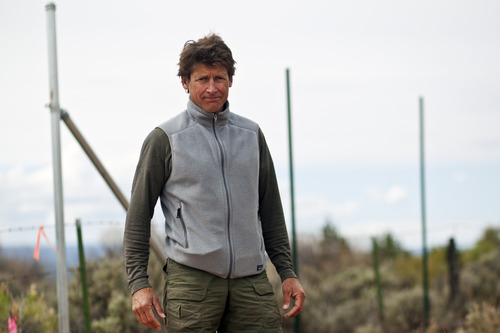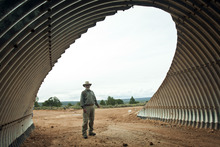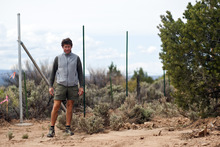This is an archived article that was published on sltrib.com in 2013, and information in the article may be outdated. It is provided only for personal research purposes and may not be reprinted.
Kanab • Automobiles strike about 100 mule deer each year on a lovely stretch of U.S. Highway 89 in Kane County, killing up to 10 percent of the Paunsaugunt herd.
Now officials hope a $2.6 million system of fencing and underpasses under construction will slash next fall's roadside carcass count and make the road safer for motorists. In partnership with two state wildlife agencies, sportsmen, the county and the Grand Staircase-Escalante National Monument, the Utah Department of Transportation has adapted four existing culverts and built three new ones specifically for wildlife on this stretch of highway east of Kanab.
"You can't get to zero fatalities without wildlife crossings. The wildlife benefits are great as well," said UDOT engineer Monte Aldridge during a press tour of the project last week.
But the investment, largely funded by the Bureau of Land Management, will pay rich dividends in terms of enhancing the ecological health of this scenic region.
"Wildlife needs to move, like they need food and water. Roads have largely blocked the movement of animals. We need wildlife corridors," said conservationist John Davis who is himself hiking, biking and paddling through Utah this month. His 7,000-mile TrekWest journey from Mexico to Canada is promoting the importance of natural connections between landscapes. Davis stopped in Kanab to highlight the wildlife crossing's promise in protecting these connections, before heading up Paria Wash.
Utah installed the first wildlife crossing in North America in 1971, an overpass south of Beaver, according to Aldridge. These features have come a long way since and UDOT is actively examining places where wildlife migration routes intersect highways for future projects, such as U.S. Highway 6 and State Route 10.
"We look for a high density of wildlife collisions and the right topography. Not all corridors lend themselves to a successful project," Aldridge said.
It helps if the landscape naturally funnels wildlife to a spot where underpasses either already exist or can be built without raising the road surface. The Highway 89 project will be the subject of a five-year research project by Utah State University.
The wildlife crossing begins where the highway enters the national monument with 8-foot fences of a four-inch mesh, stretching along both sides of the road for 12 miles. Authorities hope the fencing funnels migrating wildlife, including coyote, foxes and bobcats, to and through the seven underpasses in that stretch.
According to Montana State University's Western Transportation Institute, deer collisions cause on average $6,600 property damage. Even at the more conservative estimates UDOT uses, the cost of the Highway 89 project will likely be realized in savings to motorists within 10 years.
On their 100-mile migrations between the monument and their winter range on Arizona's Kaibab Plateau, the Paunsaugunt deer cross the highway heading south in October and back north in March, according to Bruce Bonebrake, a Utah Division of Wildlife Resources regional supervisor who helped design the project. Standing in a new 12-foot-high culvert at mile post 44 Thursday, he pointed out aspects that make these passages function well or poorly.
"Once these deer learn to use these structures, [the highway] won't be much a barrier. The approaches are what's important. [Deer] want to see where they are going," he said, gesturing at the wide open view of the Kaibab Plateau when looking south. The view north through the corrugated steel tunnel, however, looked onto a berm of disturbed earth, which Bonebrake feared could give northbound deer pause.
USU wildlife biologists will rig the passages with motion-sensitive cameras to record animals passing through the features, as well as those that approach and turn back.
"It is important to know when the 'repel rate' goes down," Bonebrake said, "and the animals accept this passage."


